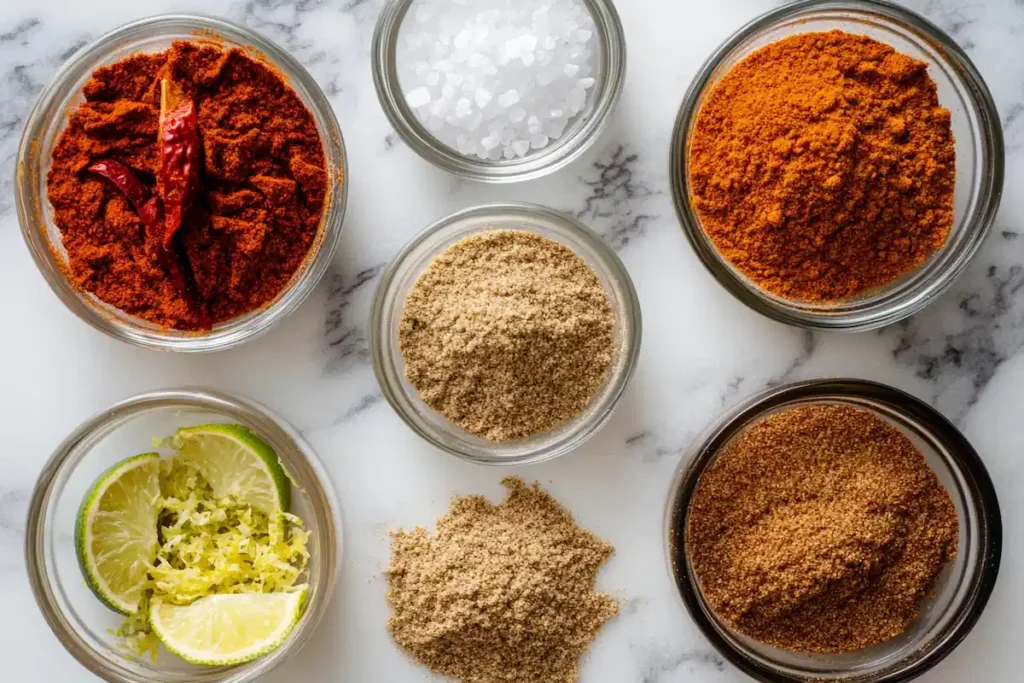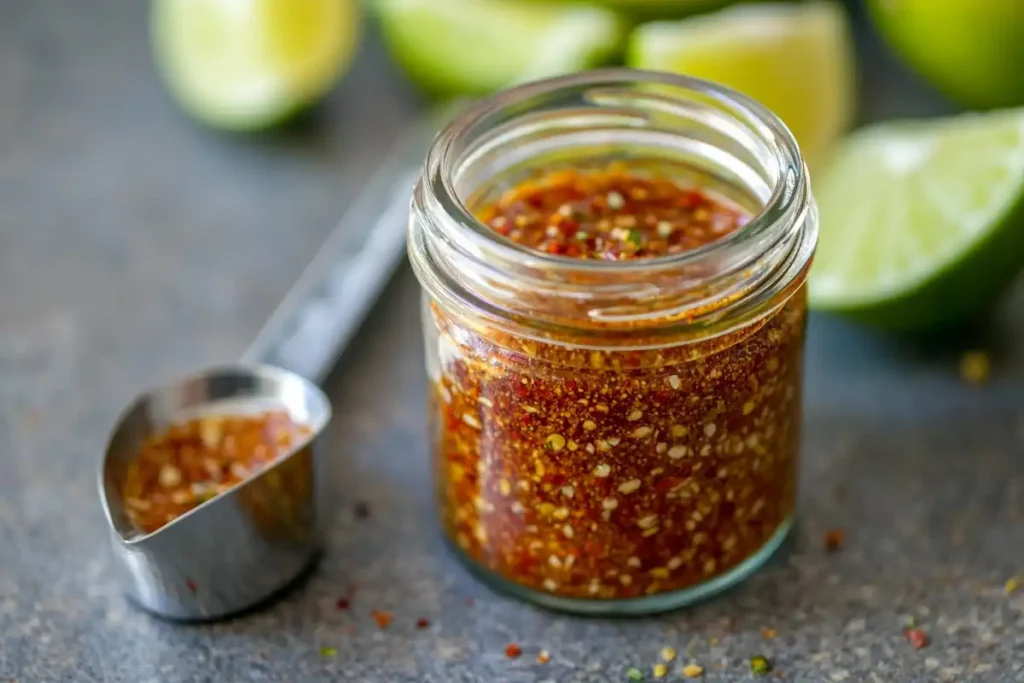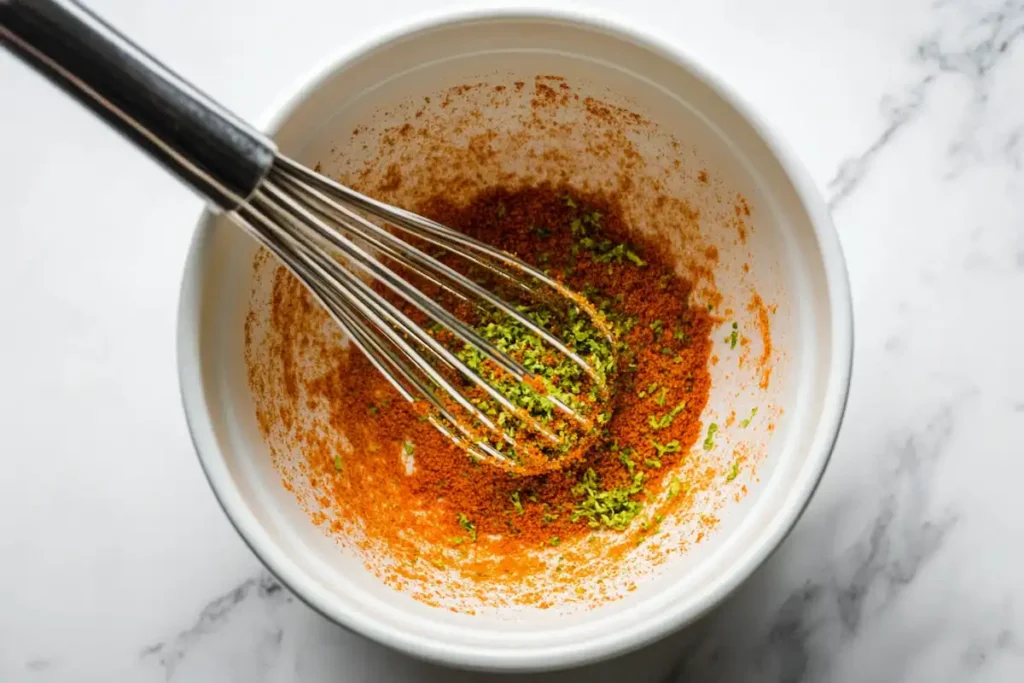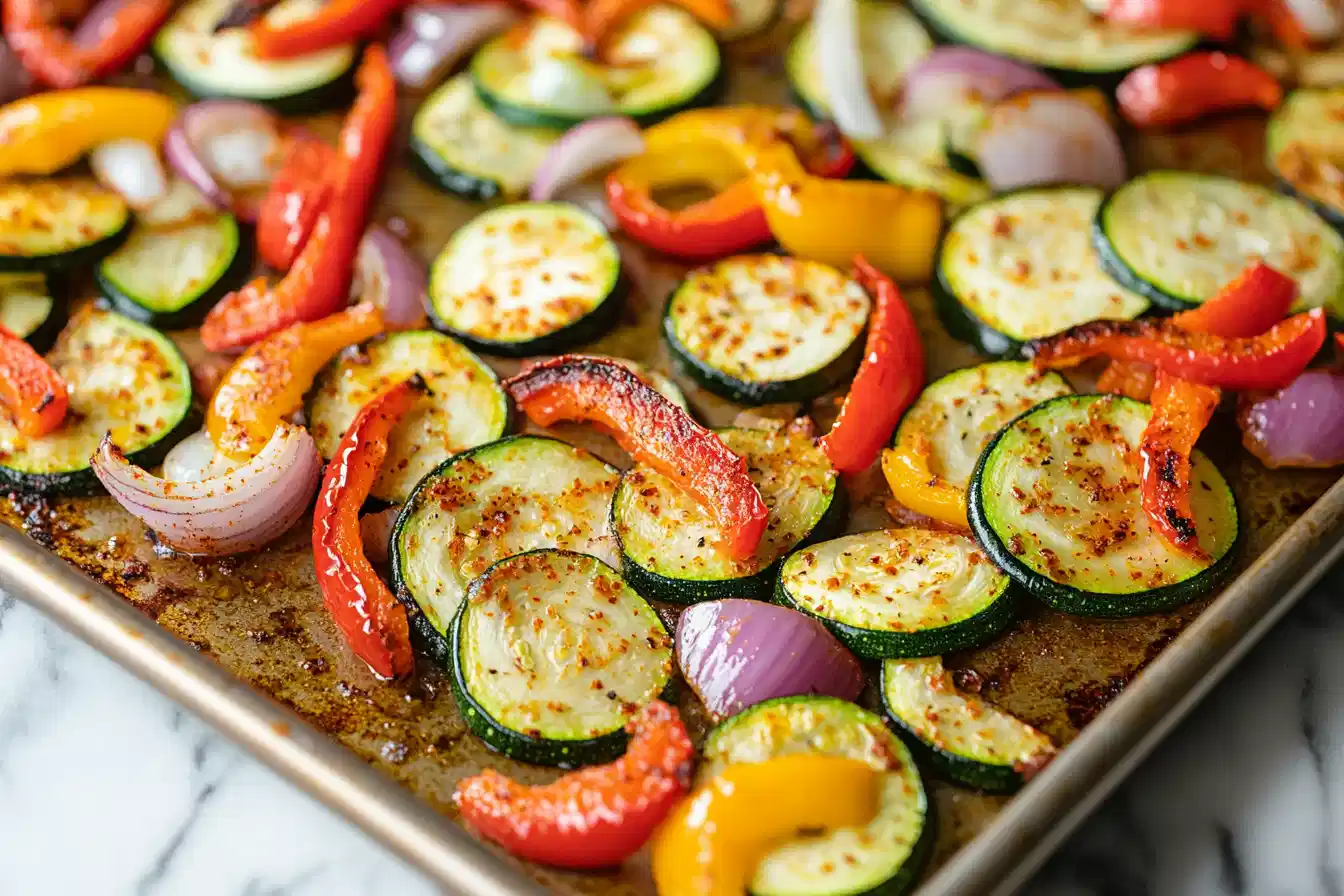Discover how chili lime seasoning adds tangy heat to meals, plus recipes and health tips in this comprehensive guide.
Introduction
Chili lime seasoning has become a go-to spice blend for home cooks seeking a burst of tangy heat in their dishes. Its dynamic mix of chili peppers and lime flavors transforms ordinary foods into vibrant meals. In the United States, this zesty seasoning continues to gain recognition for its ability to elevate everything from grilled meats to veggie snacks. However, there is more to chili lime seasoning than spice and citrus. Therefore, this in-depth article explores its history, key ingredients, health benefits, homemade recipe, and various uses. Whether you are looking to liven up your roasted vegetables or experiment with new tastes, chili lime seasoning may be the perfect all-in-one flavor boost.
Table of Contents
A Brief History of Chili Lime Seasoning
To fully understand chili lime seasoning, it helps to explore its cultural and culinary background. Although chili peppers and lime might seem like a modern fusion, they have deep roots in traditional cooking around the globe.
Latin American and Southeast Asian Influences
Chili peppers and lime have long been staples in Latin American cuisines, where the tang of citrus balances the heat of chilies in many classic dishes. For example, Mexican street food often features fresh limes, chili powders, and salt sprinkled over fruit or used as marinades for meat. In addition, Southeast Asian cuisines similarly pair spicy peppers with sour flavors like lime or tamarind. Therefore, these culinary traditions created the perfect environment for the development of chili-lime-inspired blends.
Chili Lime Seasoning in the U.S.
Over time, global food trends made their way into American kitchens. Diners began discovering how a balanced blend of chili and lime could intensify the taste of tacos, grilled vegetables, and even fruit salads. As interest in international cuisine expanded, so did demand for convenient spice mixes. Thus, brands started packaging chili lime seasoning, making it easier than ever for home cooks to enjoy bold, tangy flavors without sourcing all the individual ingredients.
Interested in other flavor-packed seasonings? Check out our tips on French Fry Seasoning for more ideas on spicing up your favorite sides.
Key Ingredients and Flavor Profile of Chili Lime Seasoning

A typical chili lime seasoning features a blend of spicy chili powder, bright lime essence, and complementary spices that enhance both heat and tang.
Common Components of Chili Lime Seasoning
- Chili Peppers: Varieties such as cayenne, ancho, or chipotle are often used to create a spicy backbone.
- Lime: Lime zest or dehydrated lime powder contributes a fresh, citrusy kick.
- Salt: Balances and heightens the flavor profile, though you can adjust the amount to suit your taste.
- Additional Spices: Garlic powder, onion powder, paprika, cumin, or sugar can round out the flavor.
Balancing Tangy and Spicy Tastes
The sharp burst of lime acts as a foil to chili peppers’ heat, creating a vibrant sensation on the palate. Therefore, the ideal chili lime seasoning strikes a balance between tang and spice, neither overshadowing the other. Some blends include a hint of sweetness—like sugar or agave powder—to smooth out the spiciness.
Selecting Quality Ingredients
High-quality ingredients can make a notable difference in taste. To ensure the best results, consider choosing organic spices and real lime zest rather than artificial flavorings. In addition, you can experiment with different chili powders or dried peppers, such as smoked paprika or guajillo, to craft your perfect flavor blend.
Health Benefits and Nutritional Insights
Chili lime seasoning not only tastes great but may also offer healthful properties when consumed in moderation. Because it often combines chili peppers with citrus, this blend provides several potential benefits.
Potential Health Perks
- Capsaicin from Chili Peppers
- Capsaicin is the compound responsible for chilies’ heat. Research suggests it may support metabolism and possess anti-inflammatory effects.
- Vitamin C from Lime
- Lime zest contains vitamin C, an antioxidant that supports immune function.
- Spice-Induced Satiety
- Spicy foods can help you feel fuller faster, potentially benefiting portion control.
H3: Moderation and Considerations
However, it is essential to monitor sodium levels if you rely on store-bought chili lime seasoning. Many commercial blends contain salt in significant amounts. Moreover, individuals with sensitive stomachs or acid reflux may need to limit spicy foods. Therefore, opt for blends with less chili heat or use less seasoning to suit your tolerance.
Nutritional Comparison
Chili lime seasoning generally has more to offer than a standard chili powder, which lacks the tangy zing of lime. Although the nutritional variations are not dramatic, the citrus element can provide a slight boost in essential vitamins.
Homemade Chili Lime Seasoning Recipe

Making your own chili lime seasoning ensures that you control the flavor intensity, sodium level, and freshness. It is surprisingly easy, and you can customize the ingredients to match your heat preferences.
Advantages of a DIY Blend
- Flavor Control: Adjust the chili powder’s heat level or lime content to your liking.
- Fresher Taste: Homemade mixes tend to taste brighter and more aromatic.
- Cost-Effectiveness: Buying whole spices or making your own lime zest can be more budget-friendly over time.
Ingredients List
Use this as a base recipe, then tailor it to create your perfect chili lime seasoning:
- 2 tablespoons chili powder (mild or spicy)
- 1 tablespoon paprika (regular or smoked)
- 1 tablespoon dried lime zest or lime powder
- 1 teaspoon cumin (optional)
- 1 teaspoon garlic powder
- 1 teaspoon onion powder
- 1 teaspoon salt (adjust to taste)
- 1 teaspoon sugar (optional, for sweetness)
- ¼ teaspoon cayenne pepper (for extra heat, optional)
Tip: If you do not have dried lime zest, you can dehydrate fresh lime peels on low heat in your oven, then grind them into a powder.
Step-by-Step Preparation

- Measure the Spices
- Gather and measure all spices into separate small bowls or spoons. This helps you maintain accuracy and adjust proportions as needed.
- Combine Thoroughly
- In a mixing bowl, whisk together the chili powder, paprika, dried lime zest, cumin, garlic powder, onion powder, salt, and any optional ingredients. Stir until well combined.
- Taste and Adjust
- Sample a small portion. If you prefer more tang, add another half-teaspoon of lime zest. If you want spicier notes, include more cayenne or chili powder.
- Store Properly
- Transfer the chili lime spice mix to an airtight jar or container. Keep it away from heat and direct sunlight to preserve its flavor.
Recipe Variations
- Low-Salt Version: Decrease or eliminate the salt.
- Sweet and Spicy: Add more sugar or sweetener to balance intense heat.
- Smoky Twist: Swap in chipotle powder or smoked paprika for a richer, smoky tone.
Nutritional Overview (per 100g)
Below is a general approximation of the nutritional profile for a typical homemade chili lime seasoning blend. Actual values will vary depending on specific ingredients and salt content.
| Nutrient | Approximate Amount |
|---|---|
| Calories | 200 kcal |
| Total Fat | 7 g |
| Sodium | 2,800 mg |
| Carbohydrates | 30 g |
| Fiber | 14 g |
| Protein | 7 g |
| Vitamin C | 10 mg |
| Iron | 4 mg |
This table reflects an estimated nutritional breakdown for a chili lime seasoning mix containing standard spices and salt. Adjust the salt or sugar in the recipe to alter these values.
Culinary Uses and Serving Ideas for Chili Lime Seasoning
Chili lime seasoning transcends cultural boundaries and can be applied to countless recipes. Whether you prefer quick snacks or elaborate meals, this zesty blend offers something for every palate.
Classic Applications
- Fruit Topping
- Many enjoy chili lime seasoning sprinkled over fresh fruit like mango, watermelon, or pineapple. The tangy spice elevates the natural sweetness, making it a refreshing snack.
- Roasted Vegetables
- Season zucchini, carrots, or Roasted Brussels Sprouts with chili lime spice for a vibrant side dish.
- Marinades for Meat or Fish
- Blend chili lime seasoning with oil and lemon juice for a marinade. This flavor booster works well on chicken, seafood, or tofu.
Everyday Cooking with Chili Lime Seasoning
- Tacos and Burritos
- Elevate your taco fillings by sprinkling chili lime spice onto sautéed veggies, beans, or ground meat.
- Stir-Ins for Soups
- Give chili or stews a tangy jolt by adding a teaspoon of chili lime seasoning during cooking.
- Salad Dressings
- Mix the blend with olive oil, vinegar, and a touch of sweetener to create a zesty dressing for salads or grain bowls.
Unexpected Pairings
- Popcorn
- A dash of chili lime seasoning can transform plain popcorn into a gourmet treat.
- Homemade Chips
- Lightly brush corn tortillas with oil, cut into triangles, sprinkle on the seasoning, and bake until crispy.
- Mocktails or Cocktails
- Rim the glass of your favorite fruity drink with chili lime seasoning for a tangy, spicy edge. (Opt for a non-alcoholic beverage if you prefer.)
Looking for more creative meal options? Check out our Mexican Street Corn Pasta Salad to see how spicy, tangy flavors can elevate summer dishes.
Store-Bought vs. Homemade Chili Lime Seasoning
Chili lime seasoning is widely available, but deciding whether to buy a pre-made blend or mix your own depends on your needs and preferences.
Pros and Cons of Commercial Blends
- Pros: Ready-made, convenient, and often stable for longer periods.
- Cons: Some contain artificial flavorings, excessive sodium, or anti-caking agents that can affect taste.
Reading Labels and Making Informed Choices
When shopping for chili lime seasoning, carefully read the ingredient list and watch for fillers or ingredients you prefer to avoid. Look for labels that specify real lime, natural chili powders, and minimal preservatives.
When to Pick Store-Bought
If you are pressed for time or experimenting with chili lime seasoning for the first time, buying a small container might be easier. You can still enhance the flavor with fresh lime juice or a unique spice of your choice after opening.
Common Mistakes to Avoid
Even though chili lime seasoning can seem foolproof, a few pitfalls can diminish its overall impact.
- Overdoing the Lime
- Too much lime powder can overwhelm the dish, producing a bitter or overly sour taste. Taste-test frequently and adjust slowly.
- Ignoring Salt Content
- Many commercial blends already contain salt. Adding extra salt before trying your dish can lead to a salty surprise. Therefore, season in stages.
- Poor Storage Habits
- Exposure to moisture or direct sunlight can degrade the spices quickly. Always keep your chili lime seasoning in an airtight container in a cool, dry place.
Frequently Asked Questions (FAQs)
What do you use chili lime seasoning for?
Chili lime seasoning is versatile and can be used on meat, seafood, roasted vegetables, fresh fruit, popcorn, and even salad dressings. The tangy and spicy combination enhances both savory and sweet dishes, making it a great all-purpose flavor booster.
Is chili lime seasoning the same as Tajín?
Although chili lime seasoning shares similarities with Tajín, they are not always identical. Tajín is a specific Mexican brand known for its combination of mild chili peppers, lime, and salt. Store-bought chili lime blends can vary in their spice mix, heat level, or added ingredients like garlic and sugar. Therefore, while they have similar flavor profiles, they are not necessarily interchangeable.
What can I use instead of chili lime?
If you do not have chili lime seasoning on hand, you can combine a standard chili powder with some fresh lime zest or lemon juice. In addition, a dash of salt or sugar can help achieve a balanced taste. You may also explore alternative spice mixes that include tangy elements, like a lemon pepper seasoning.
What is a substitute for Tajín seasoning?
A homemade blend of chili powder, lime zest (or dehydrated lime), and salt can mimic the essence of Tajín. However, Tajín has its own signature taste due to its specific chili blend, so your substitution might not be an exact match. Nevertheless, you can closely replicate the tangy, spicy profile with quality spices and fresh citrus.
Conclusion
Chili lime seasoning stands out as a convenient, flavorful option for home cooks looking to add a tangy punch to their dishes. With roots in Latin American and Southeast Asian cooking, this blend leverages the synergy between spicy chilies and bright lime. Whether you want a quick dusting on fresh fruit or a robust marinade for grilled meats, chili lime seasoning offers endless possibilities. Most importantly, you can customize its intensity, saltiness, and sweetness when making it yourself.
Therefore, feel free to experiment with different spice levels, fresh zests, or unique ingredients. Remember to store your seasoning properly and sample it in stages to avoid over-seasoning. Ultimately, chili lime seasoning can spark creativity in the kitchen, turning simple meals into memorable culinary adventures.

